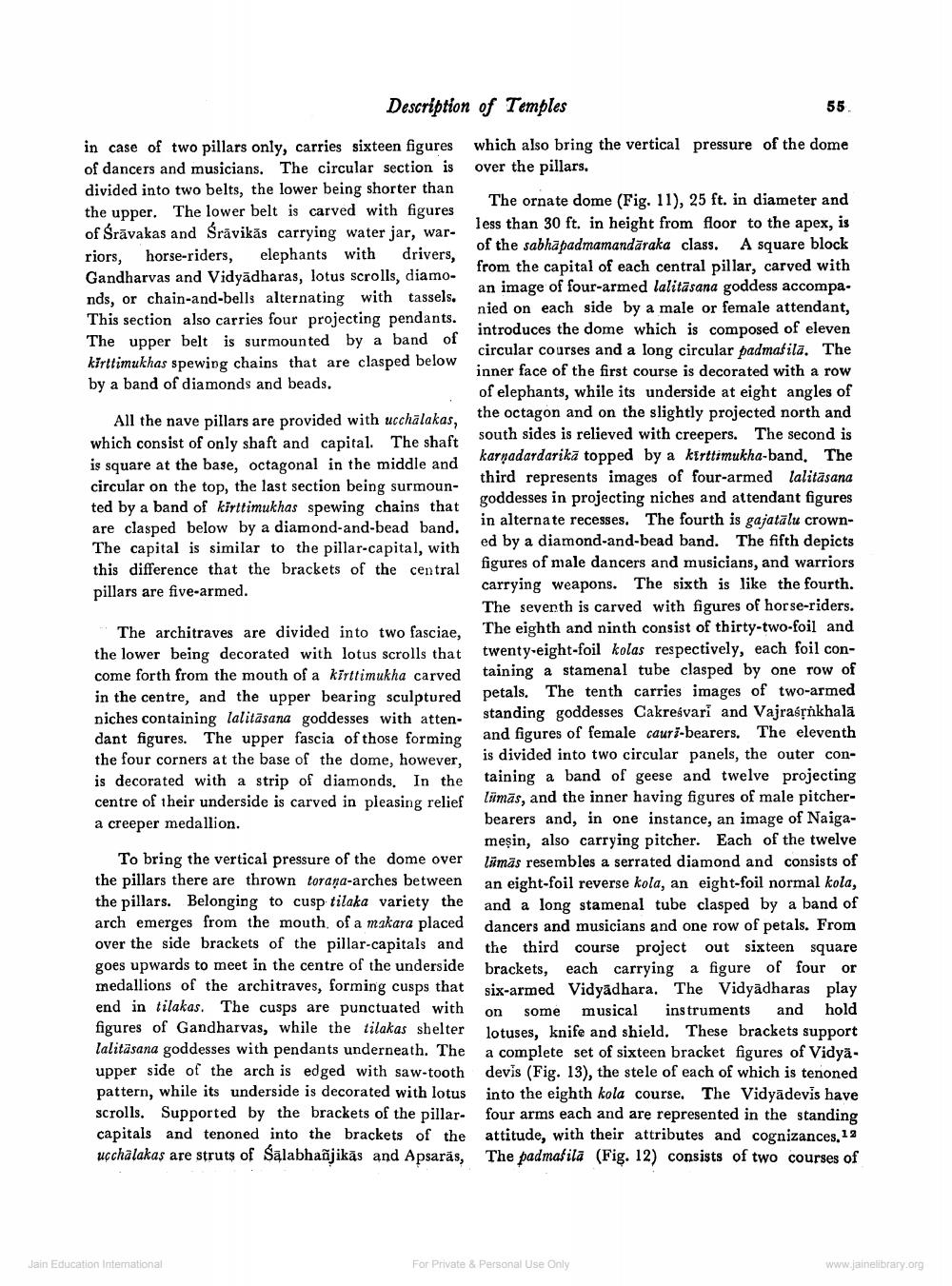________________
Description of Temples
55
in case of two pillars only, carries sixteen figures which also bring the vertical pressure of the dome of dancers and musicians. The circular section is over the pillars. divided into two belts, the lower being shorter than
The ornate dome (Fig. 11), 25 ft. in diameter and the upper. The lower belt is carved with figures of Śrāvakas and Srävikäs carrying water jar, war
less than 30 ft. in height from floor to the apex, is
of the sabhapadmamandāraka class. riors, horse-riders,
A square block elephants with drivers,
from the capital of each central pillar, carved with Gandharvas and Vidyadharas, lotus scrolls, diamo
an image of four-armed lalitā sana goddess accompa. nds, or chain-and-bells alternating with tassels.
nied on each side by a male or female attendant, This section also carries four projecting pendants.
introduces the dome which is composed of eleven The upper belt is surmounted by a band of
circular courses and a long circular padmašila. The kirttimukhas spewing chains that are clasped below
inner face of the first course is decorated with a row by a band of diamonds and beads.
of elephants, while its underside at eight angles of All the nave pillars are provided with ucсhālakas,
the octagon and on the slightly projected north and which consist of only shaft and capital. The shaft
south sides is relieved with creepers. The second is is square at the base, octagonal in the middle and
karşadardarikā topped by a kirttimukha-band. The
third represents images of four-armed lalitasana circular on the top, the last section being surmounted by a band of kirttimukhas spewing chains that
goddesses in projecting niches and attendant figures are clasped below by a diamond-and-bead band.
in alternate recesses. The fourth is gajatalu crownThe capital is similar to the pillar-capital, with
ed by a diamond-and-bead band. The fifth depicts this difference that the brackets of the central
figures of male dancers and musicians, and warriors pillars are five-armed.
carrying weapons. The sixth is like the fourth.
The seventh is carved with figures of horse-riders. * The architraves are divided into two fasciae, The eighth and ninth consist of thirty-two-foil and the lower being decorated with lotus scrolls that twenty-eight-foil kolas respectively, each foil concome forth from the mouth of a kiritimukha carved taining a stamenal tube clasped by one row of in the centre, and the upper bearing sculptured petals. The tenth carries images of two-armed niches containing lalitāsana goddesses with atten
standing goddesses Cakresvari and Vajrašțnkhalā dant figures. The upper fascia of those forming
and figures of female cauri-bearers. The eleventh the four corners at the base of the dome, however,
is divided into two circular panels, the outer conis decorated with a strip of diamonds. In the
taining a band of geese and twelve projecting centre of their underside is carved in pleasing relief limās, and the inner having figures of male pitchera creeper medallion.
bearers and, in one instance, an image of Naiga
meşin, also carrying pitcher. Each of the twelve To bring the vertical pressure of the dome over lämās resembles a serrated diamond and consists of the pillars there are thrown torana-arches between an eight-foil reverse kola, an eight-foil normal kola, the pillars. Belonging to cusp tilaka variety the and a long stamenal tube clasped by a band of arch emerges from the mouth of a makara placed dancers and musicians and one row of petals. From over the side brackets of the pillar-capitals and the third course project out sixteen square goes upwards to meet in the centre of the underside brackets, each carrying a figure of four or medallions of the architraves, forming cusps that six-armed Vidyadhara. The Vidyadharas play end in tilakas. The cusps are punctuated with on some musical instruments and hold figures of Gandharvas, while the tilakas shelter lotuses. knife and shield. These brackets support lalitäsana goddesses with pendants underneath. The a complete set of sixteen bracket figures of Vidyä. upper side of the arch is edged with saw-tooth devis (Fig. 13), the stele of each of which is tenoned pattern, while its underside is decorated with lotus into the eighth kola course. The Vidyādevis have scrolls. Supported by the brackets of the pillar- four arms each and are represented in the standing capitals and tenoned into the brackets of the attitude, with their attributes and cognizances. 1 2 ucchālakas are struts of Salabhaõjikās and Apsarās, The padmašila (Fig. 12) consists of two courses of
Jain Education International
For Private & Personal Use Only
www.jainelibrary.org




